Featuring the 100-400L and 1.4x extender
Oct 21, 2018 11:59:42 #
This post continues the discussion of Canon L-series lenses used with Canon Series III extenders, showing examples from the Canon EF 100-400mm f/4.5.6 IS II USM and the EF 1.4x III Extender creating a 560mm focal length combination at the maximum zoom length. Many zoom lenses, third-party and Canon, lose a touch of sharpness at their maximum focal length. That is not the case with the 100-400L. When the 1.4x extender is used, the resulting zoom range is 140mm to 560mm. Images selected for this installment are all captured at the maximum zoom of 560mm. Two images were captured using the original 100-400L and are identified at the conclusion of the post
The current EF 100-400mm f/4.5-5.6L IS II USM was released in 2014, replacing the original model that had been a staple of wildlife photography and airshows going back to 1998. The new lens features 16-years of technology improvements. For those familiar with the original model, the Series II lens changed the zoom mechanism from a push-pull trombone style to a rotary zoom.
The Crazy Horse Memorial is located in the Black Hills of South Dakota, near the town of Berne. Like the nearby Mount Rushmore National Memorial, the monument is being carved out of a mountainside. The sculpture was begun by Polish-American sculptor Korczak Ziólkowski, who had worked under Gutzon Borglum on Mount Rushmore. Upon completion, the head of Crazy Horse will be the world’s largest sculpture of a human head, measuring approximately 87 feet (27 m) tall, more than 27 feet taller than the 60-foot faces of the U.S. Presidents depicted on Mount Rushmore. The entire sculpture of Crazy Horse riding a horse will be the largest sculpture in the world when completed.
Crazy Horse by Paul Sager, on Flickr
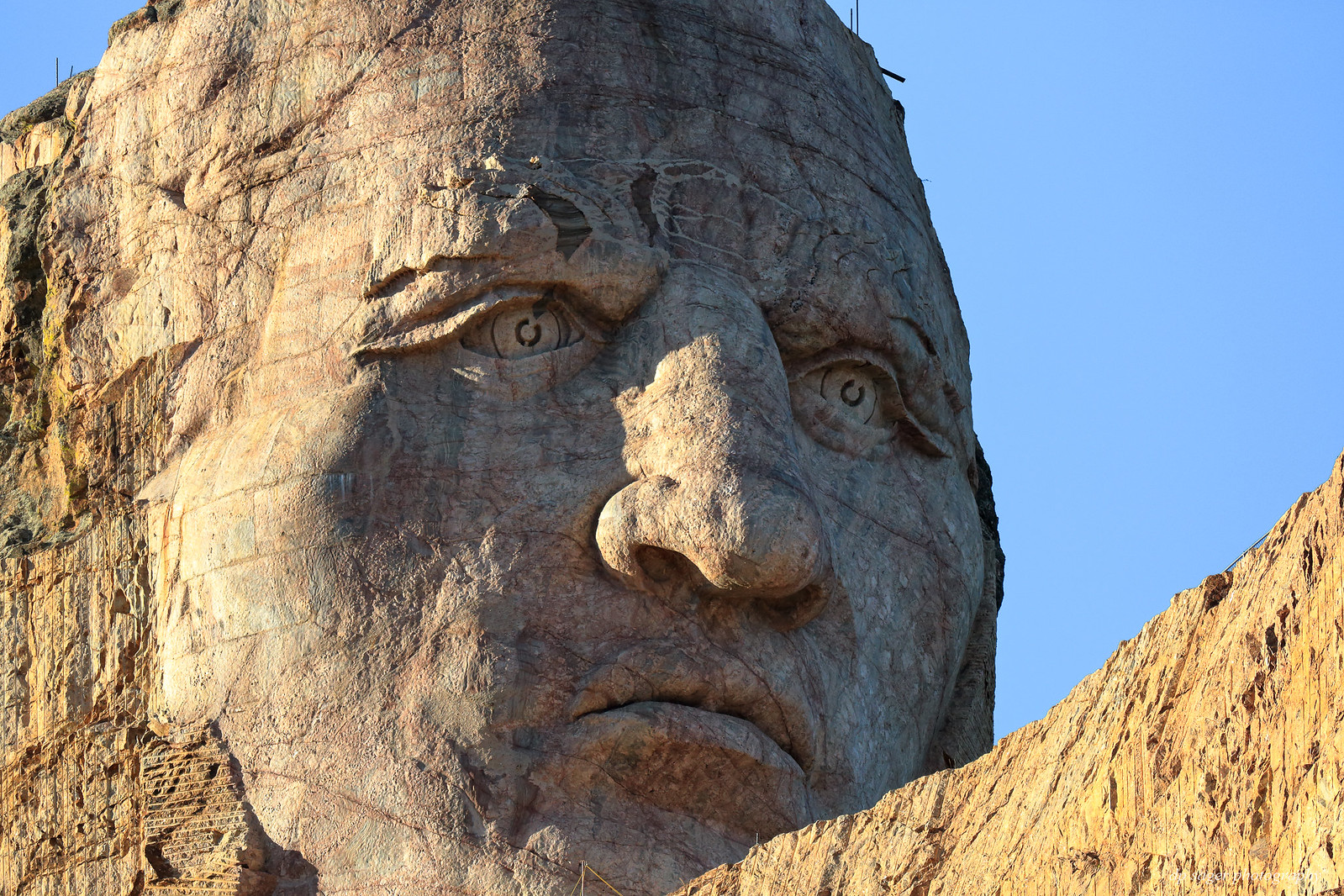
The Series II 100-400L features Canon's latest Image Stabilizer system, allowing users to shoot at speeds up to four times slower than normally required. Canon's IS-enabled lenses in Series II feature three IS modes. Mode 1 is the normal mode, used for typical photography, where the subject does not move. Mode 2 is used for panning; this is useful for sports or wildlife photography, where the subject moves constantly and one will need to pan. Mode 3, intended to track action, is similar to Mode 2 in that it ignores panning; however, it applies stabilization only when the shutter is released, the viewfinder image is not stabilized.
Chicago area Dragonflies
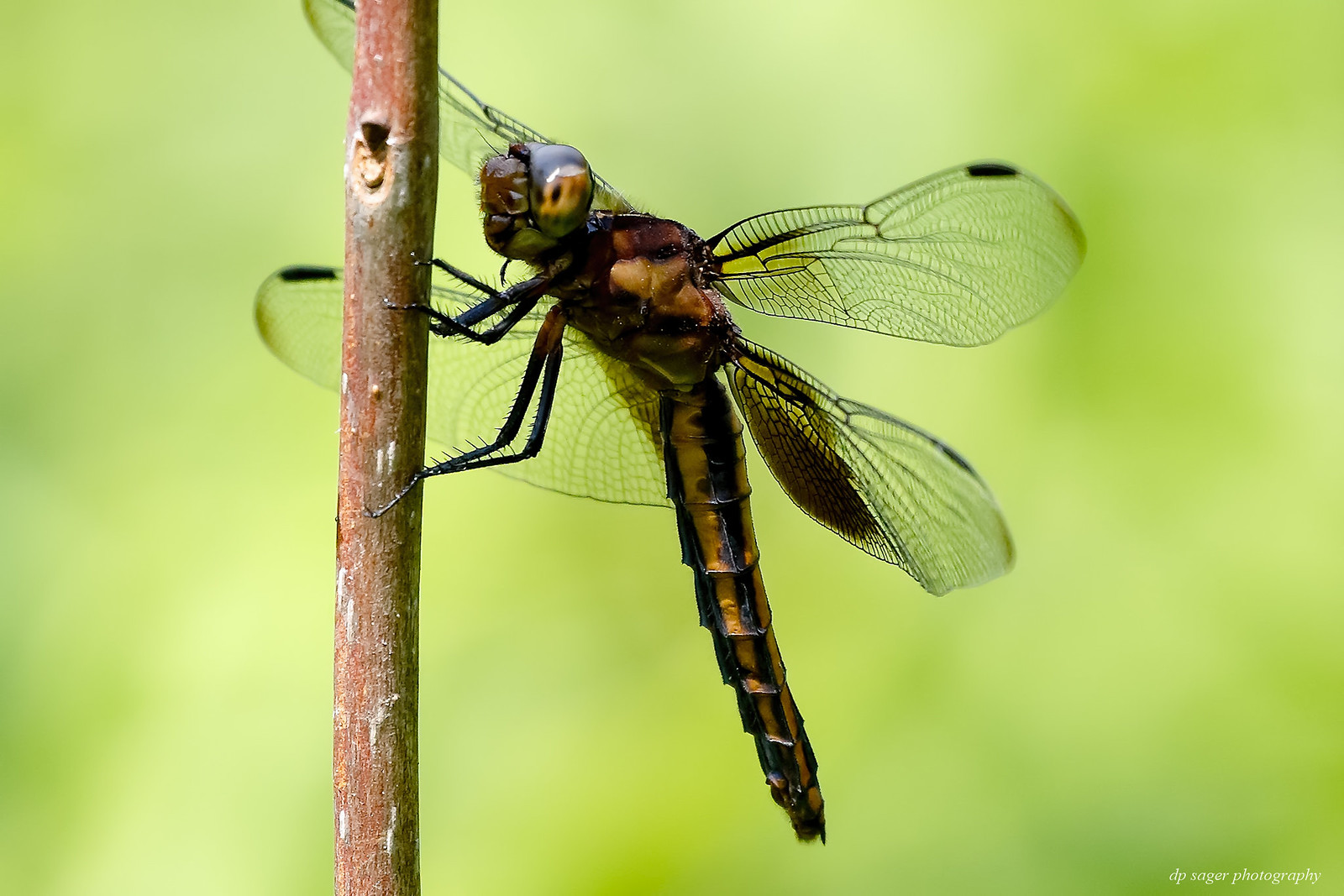
The Series II model features a dramatically shortened MFD (Minimum Focus Distance) and a significantly-increased MM (Maximum Magnification) effect. The 100-400 II can focus on subjects just 38.4-inches (980mm) from the camera sensor. This distance is nearly half the MFD of the old lens. The Series II can produce subject details 50% larger than the previous lens.
Giant Swallowtail
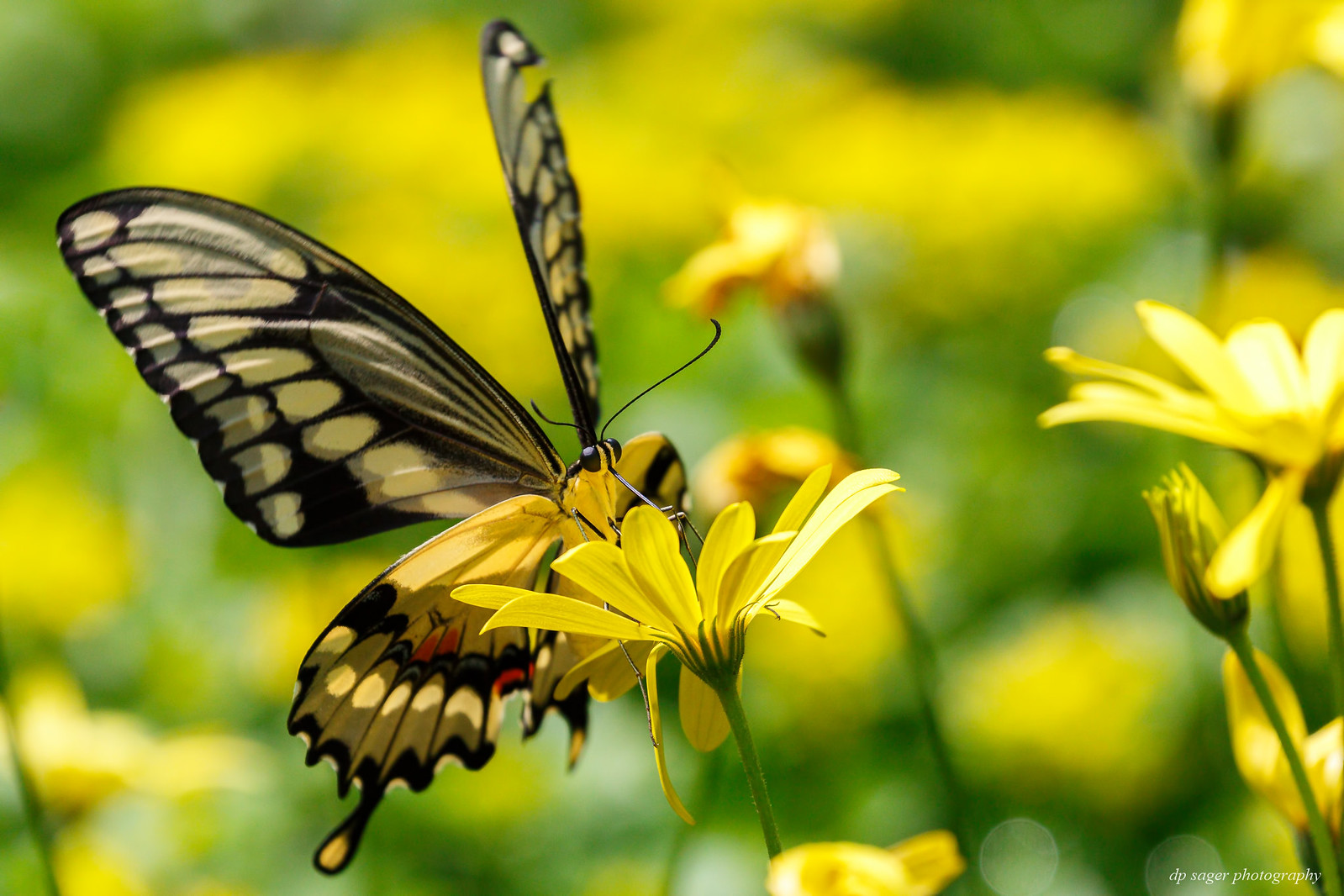
Adding the 1.4x extender creates a 140-560mm zoom lens. All the images in this post were captured using a Series III 1.4x extender at the maximum 560mm zoom length. The primary impact of using the 1.4x extender is the reduction in maximum aperture. With the 1.4x mounted behind the 100-400, the max aperture range narrows to f/6.3 - f/8 on this variable aperture lens. Historically, only the professional 1-series EOS cameras supported auto focus for lenses with maximum apertures smaller than f/5.6. Beginning with the EOS 5DIII release in 2012, Canon has extended the ability to autofocus at f/8 into an increasing number of newer EOS DSLR cameras, now including all 1D series models, the 5DIII, 5DIV, 5DS, 5DS-R, 7DII, 80D, 77D, and Rebel T7i. These Canon EOS bodies feature high density, high precision auto-focus sensors with 45 or more AF points.
Friends Good Will is a working American reproduction of the historical Friends Good Will (1811–1813), a merchant square-rigged topsail sloop that was overtaken by the events of the War of 1812. The British captured her in a ruse of war shortly after they captured Fort Mackinac, and renamed her HMS Little Belt. In British service she was armed with a 9-pounder pivot gun and two 6-pounder guns. The Americans recaptured her during the Battle of Lake Erie. She then served in the US Navy before the British destroyed her at the end of December 1813. The current vessel sails out of South Haven, Michigan at the Michigan Maritime Museum, where she brings the area's history to life through educational tours, day sails, and school field trips.
Friends Good Will
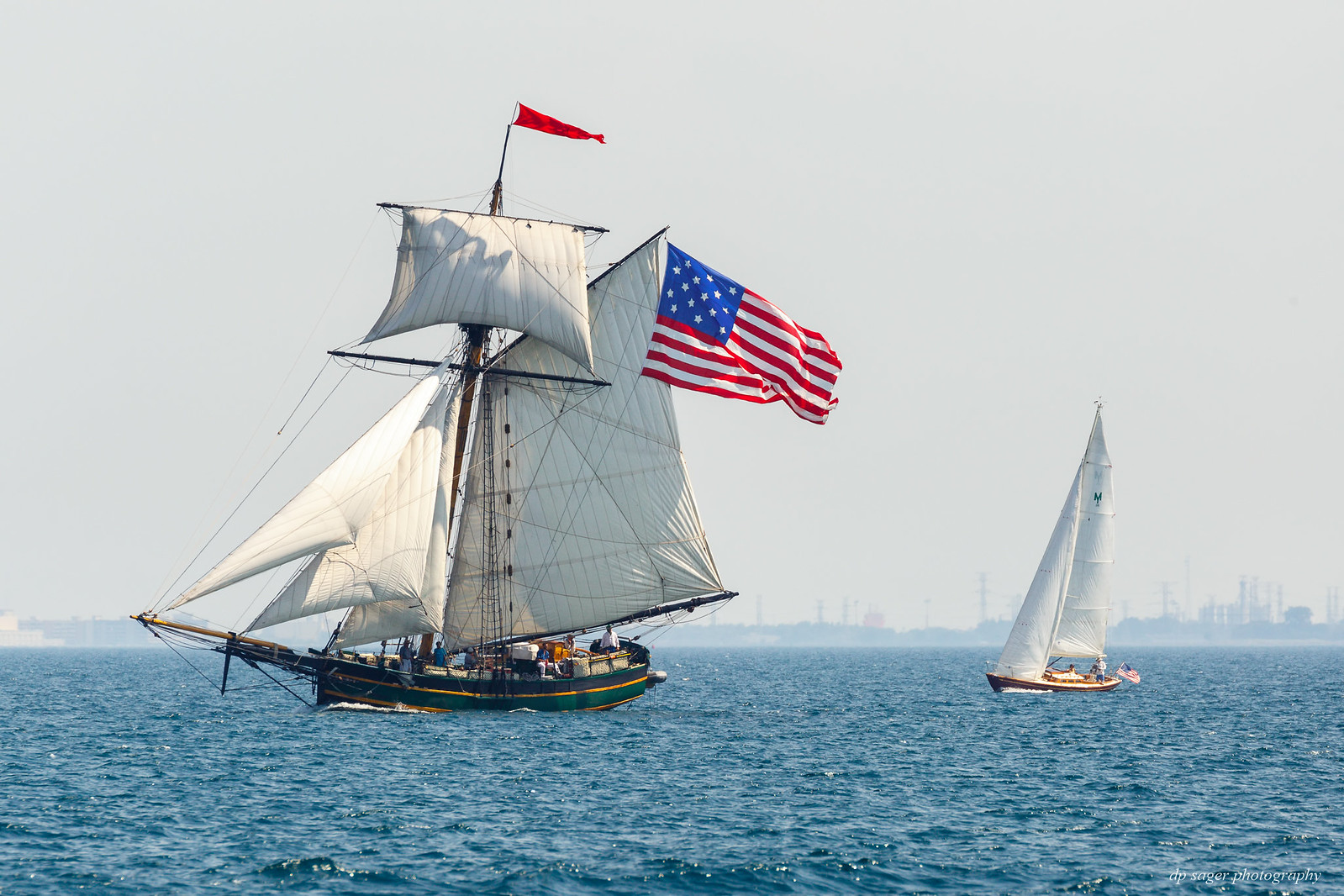
The consensus among reviewers is the new 100-400L is as sharp when using a 1.4x extender as the old lens was sharp without an extender. My own experience is consistent with this assessment. I've found the image quality with the extender improves when stepping down from the maximum of f/8. In good light for larger subjects such as airplanes flying at airshows, working at aperture settings of f/9 to f/13 show excellent sharpness with a depth of field that covers the entire plane wing to wing or from nose to tail.
The cheetah is characterised by a slender body, deep chest, spotted coat, small rounded head, black tear-like streaks on the face, long thin legs and a long spotted tail. The cheetah's lightly built, slender form is in sharp contrast to the robust build of other big cats. It is the fastest land animal and active mainly during daylight hours where hunting is their major activity. A cheetah's average running speed is 40 mph (64 km/h) and can reach 70 mph (112 km/h) for short bursts.
Cheetah
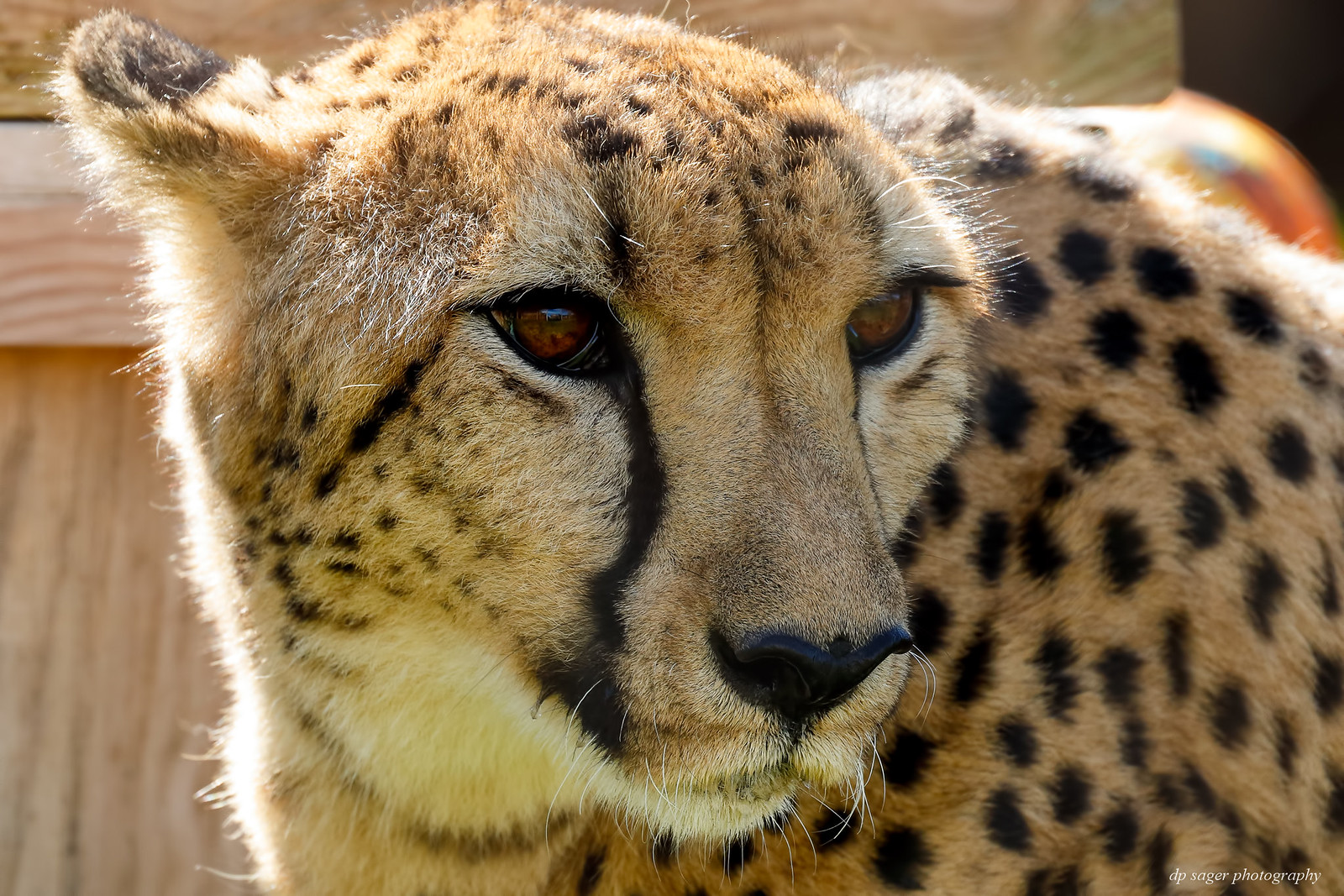
Black-tailed prairie dogs are one of five prairie dog species that once ranged the Great Plains from southern Saskatchewan to northern Mexico. French explorers called them petits chiens, or "little dogs," because of their bark-like communication. These highly social animals are actually members of the rodent family. A type of ground squirrel, prairie dogs are closely related to other squirrels, chipmunks, woodchucks and marmots.
Prairie Dog
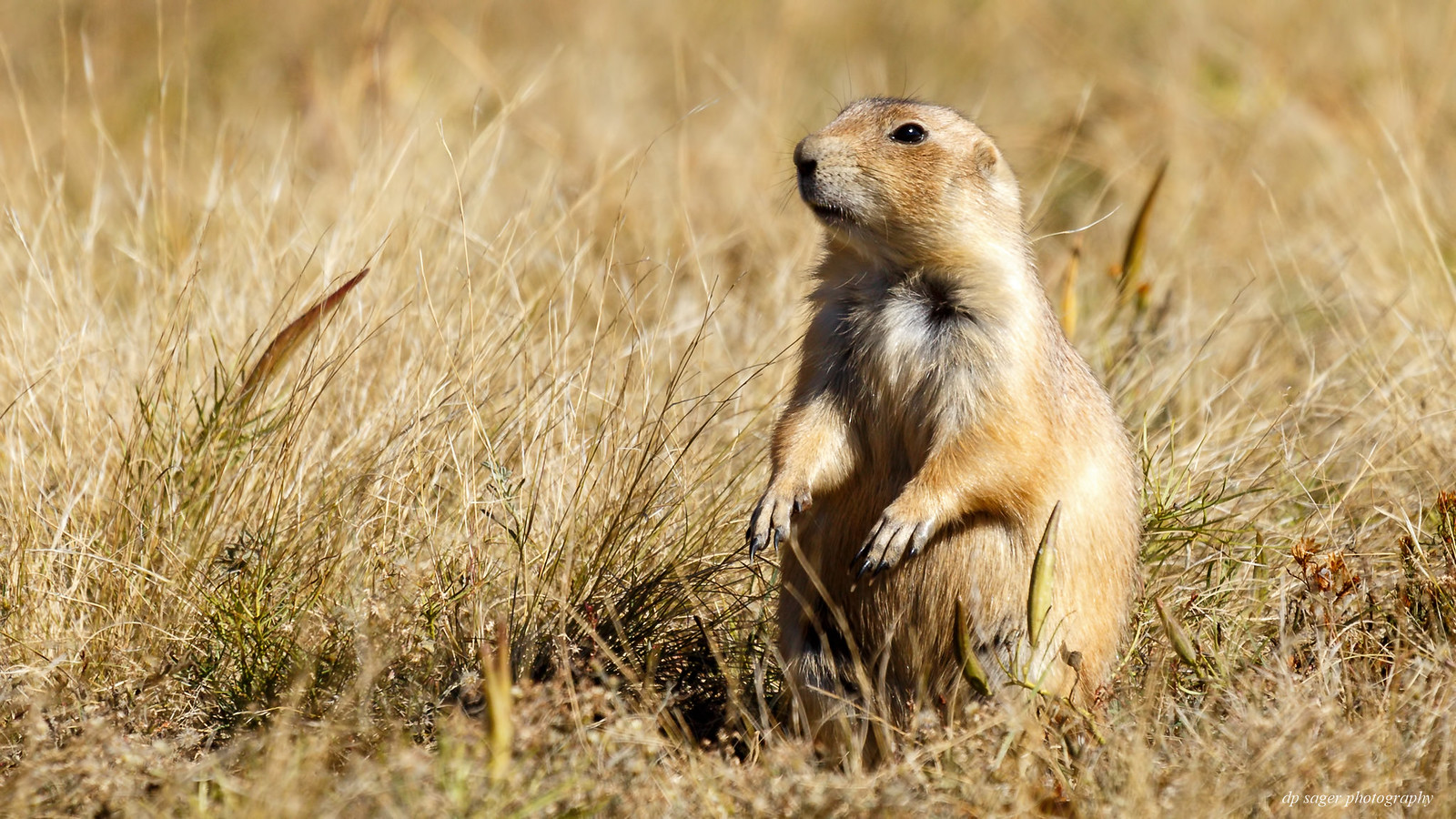
Featuring a tapering fuselage, speed ring cowling, and sloped windshield, the custom-designed biplane Dracula hearkens back to the racing airplanes of the 1930’s. Dracula combines the crowd pleasing lines of the iconic Waco Mystery Ship with modern aerodynamics and systems, creating in a smaller, lighter, significantly more maneuverable and powerful airplane.
Kyle Franklin in Dracula
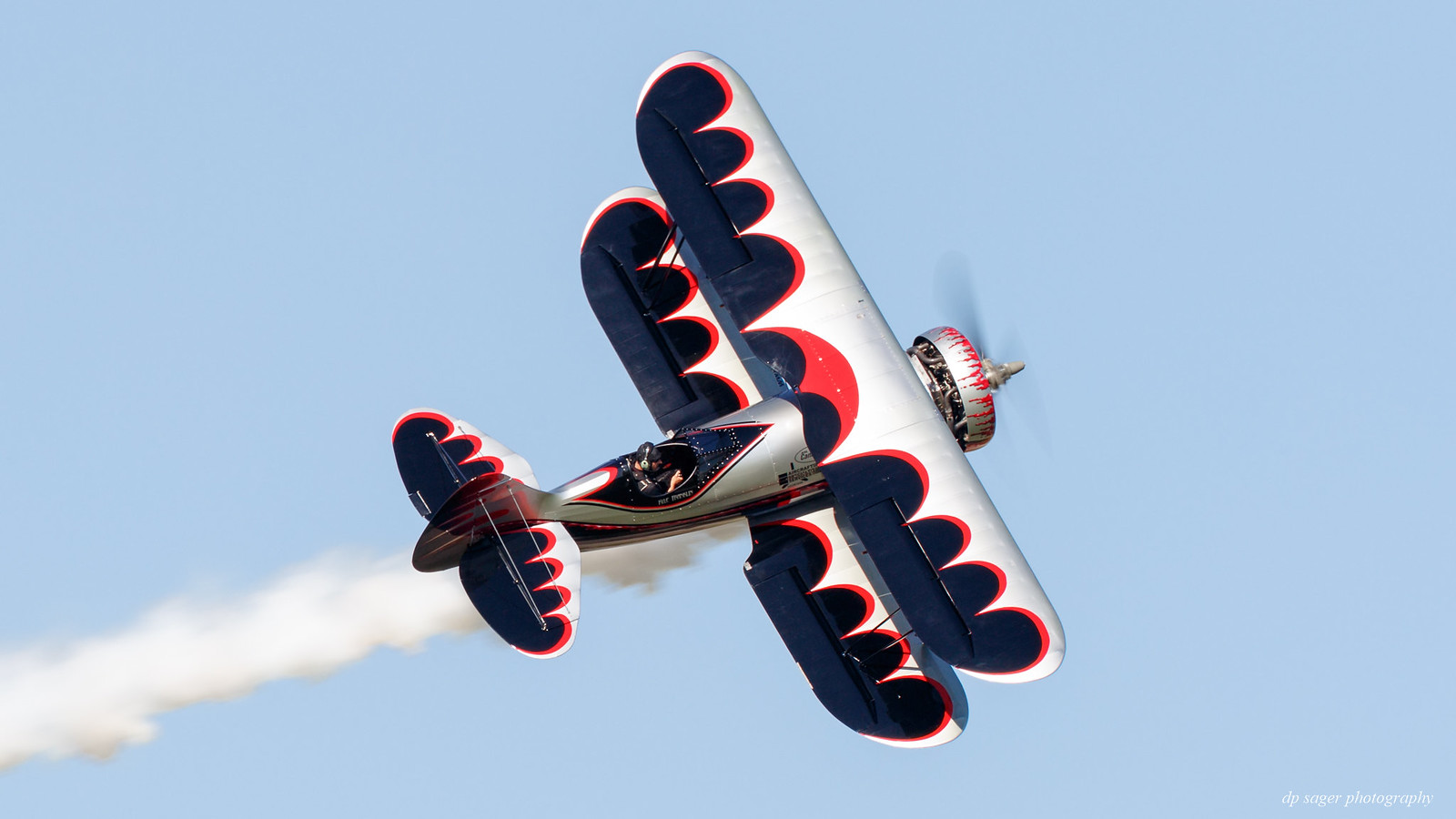
The original Canon EF 100-400mm f/4.5-5.6L IS USM lens was released in 1998. It was only the fourth EF lens, and first L-series zoom lens, to incorporate Canon's Image Stabilizer technology, effective to 2-stops in terms of shutterspeed in the original IS implementation. The lens used a push / pull zoom mechanism where the photographer extended the zoom by pushing away on the front of the lens like extending the trombone musical instrument. The lens featured a drag control allowing the photographer to adjust the tension to their personal preference for how easy (or hard) they needed to push to extend the lens.
The United States Air Force was created in 1947 as a seperate service. Previously, aerial warfare was a combat arm of the US Army, known as United States Army Air Corps and later the United States Army Air Forces until legislation established the Department of the Air Force. Just six years later, in 1953, the Air Force’s official air demonstration team, designated the 3600th Air Demonstration Unit, was activated at Luke Air Force Base, Arizona. The unit adopted the name "Thunderbirds", influenced in part by the Native American culture and folklore from the southwestern United States where Luke Air Force Base is located.
USAF Thunderbirds
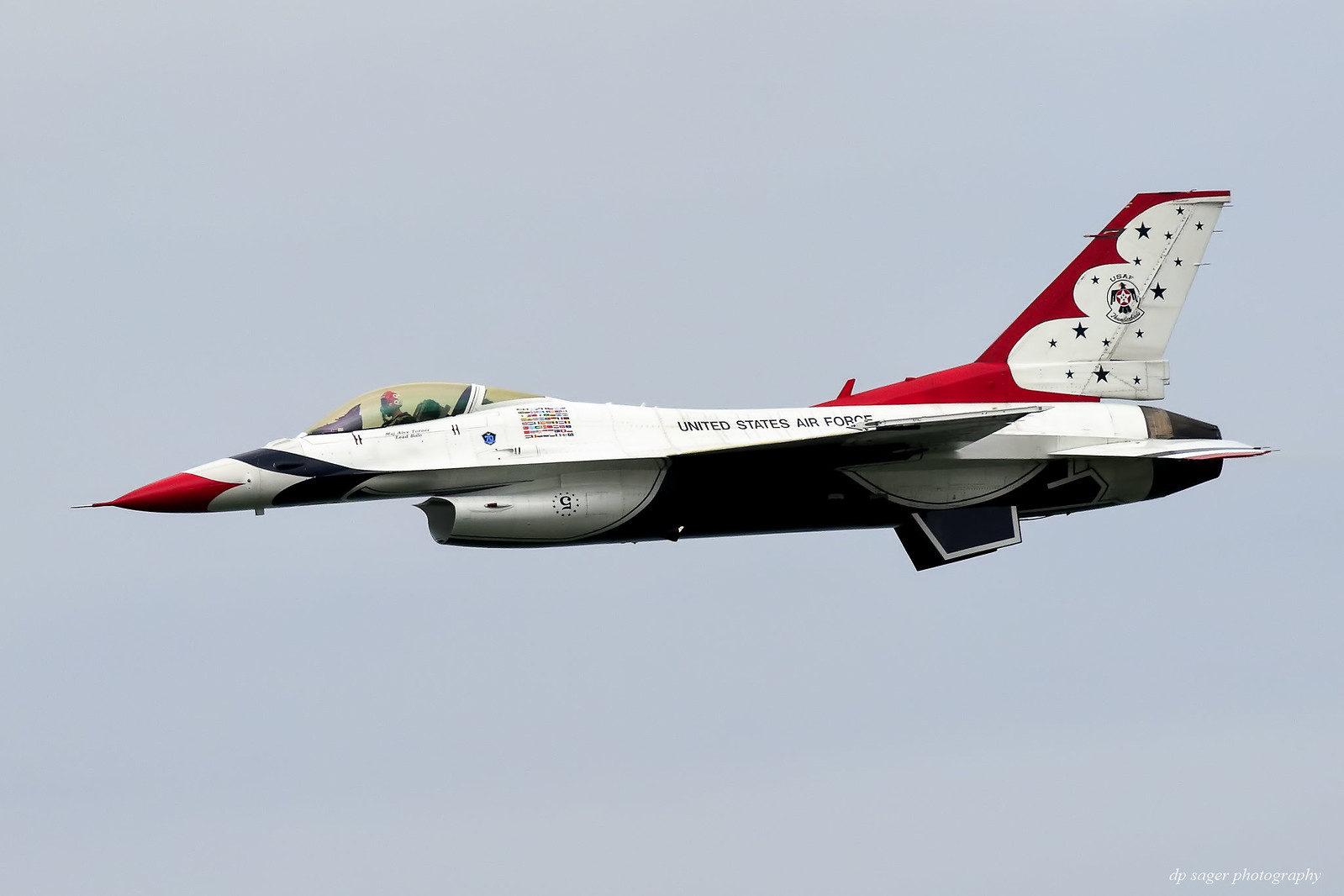
For more than 25 years, the AeroShell Aerobatic Team has performed tight formation aerial maneuvers at airshows across North America. The team was founded in 1984 by Alan Henley and Steve Gustafson as the North American Aerobatic Team. Gene McNeely joined the team in 1996 and was integral in developing the team's sponsor base. In 2001 they became the Aeroshell Aerobatic Team. The team flies the North American AT-6 Texan. Nicknamed "The Pilot Maker", the Texan was the primary training aircraft for fighter pilots in World War II, pilots who went on to fly the P-51 Mustang, F4U Corsair, P-40 Warhawk, and others.
AeroShell Aerobatic Team
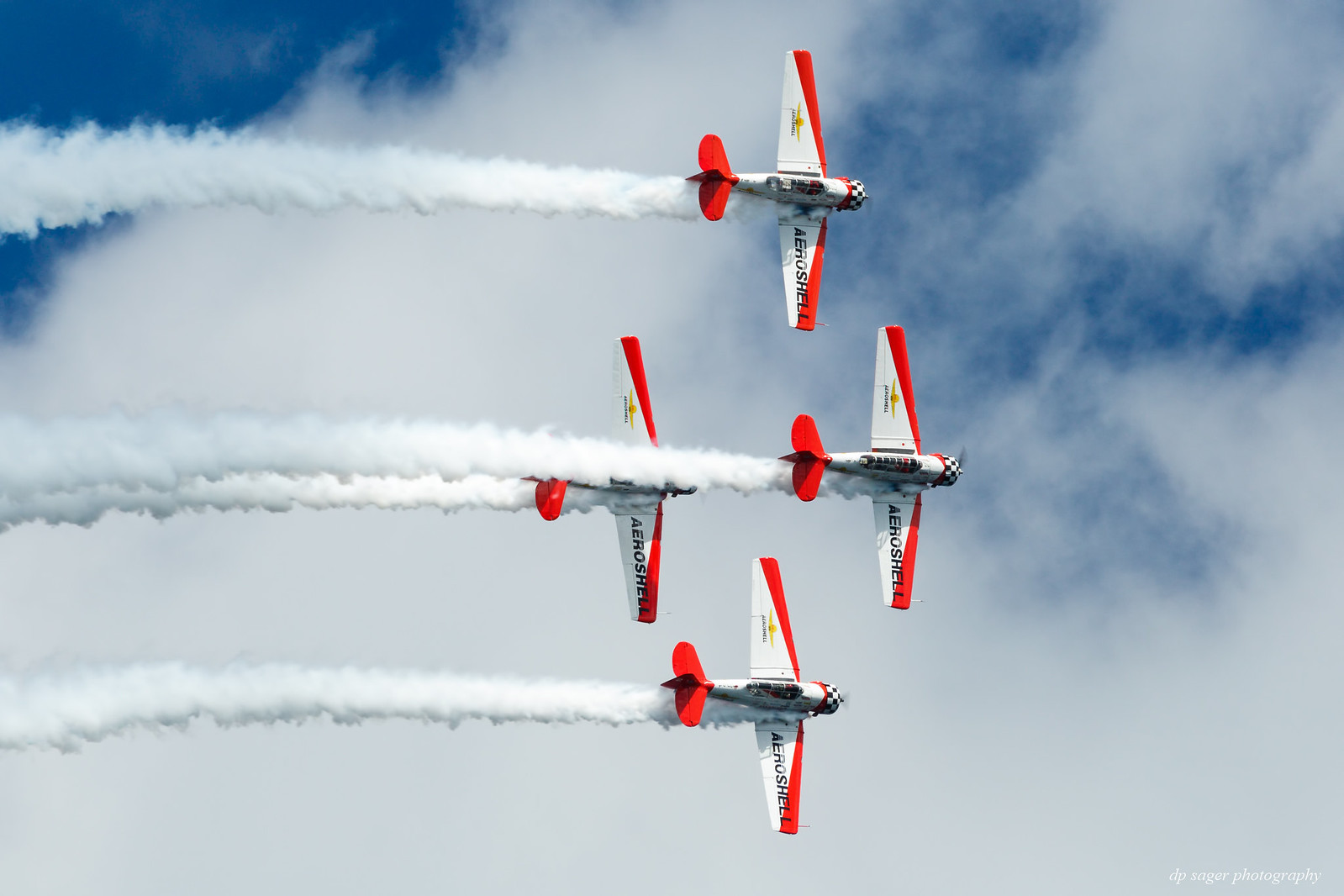
Canon L-series lenses share a number of common characteristics. L lenses tend to be more durable, incorporating dust and water-resistant rubber seals in most models. L lenses also contain optics of higher quality, with many lenses containing aspherically ground, fluorite or ultra-low dispersion glass elements. Their front elements do not rotate for the proper operation of some filters, such as circular polarizers. L lenses are often "fast", with maximum apertures commonly f/2.8 or f/4 and never exceeding f/5.6. Prime lenses have a much greater maximum aperture, such as Canon's current 50mm and 85mm L lenses which open to f/1.2. All current L-series lenses have ultrasonic autofocus motors (USM) and extra communication pins, except for the specialist tilt-shift lenses which do not provide autofocus.
Flamingo
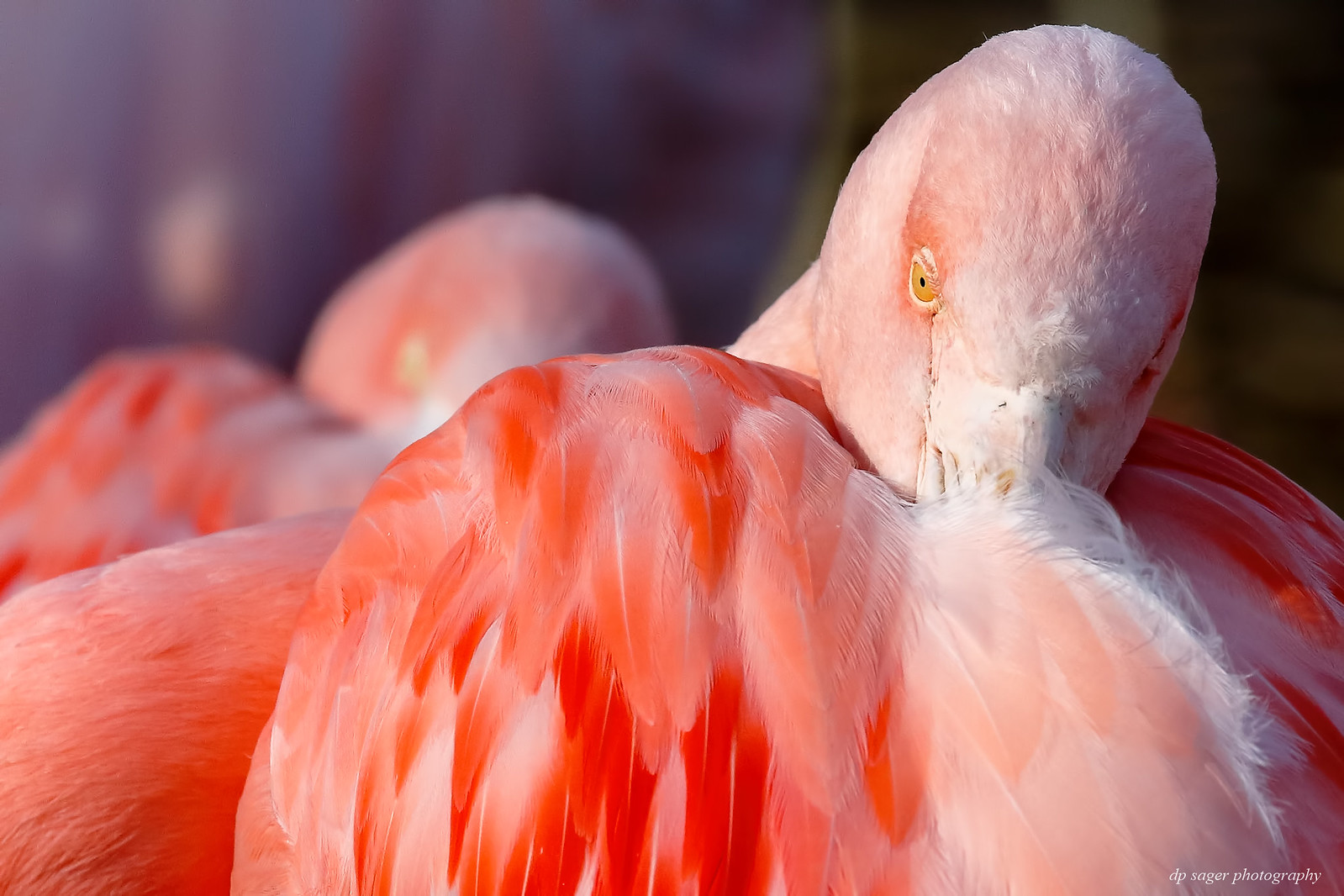
When reviewing the sample images, could you discern the two that used the older 100-400L? All images were captured using a 22MP EOS 5DIII and the same 1.4x extender III. Images were captured in Canon's CR2 Raw format and processed using Lightroom v6. Additional noise processing was completed in Topaz DeNoise v6. The first image of the Crazy Horse Memorial and the Black-tailed prairie dog came from the original EF 100-400mm f/4.5.6 IS USM. All the others used the Series II lens.
The images are sized to fill your wide-screen display. Try using <F11> to maximize your browser window for the full effect. If the images overshoot your display, such as a laptop, just click on the image or the URL link and they'll resize to your screen from the host Flickr site. You can click a bit further into the image details on the Flickr page, if desired. EXIF data is available from the host Flickr pages as well. On the Flickr site, use your <L>key for Large and the <F11> for the full-screen.
The current EF 100-400mm f/4.5-5.6L IS II USM was released in 2014, replacing the original model that had been a staple of wildlife photography and airshows going back to 1998. The new lens features 16-years of technology improvements. For those familiar with the original model, the Series II lens changed the zoom mechanism from a push-pull trombone style to a rotary zoom.
The Crazy Horse Memorial is located in the Black Hills of South Dakota, near the town of Berne. Like the nearby Mount Rushmore National Memorial, the monument is being carved out of a mountainside. The sculpture was begun by Polish-American sculptor Korczak Ziólkowski, who had worked under Gutzon Borglum on Mount Rushmore. Upon completion, the head of Crazy Horse will be the world’s largest sculpture of a human head, measuring approximately 87 feet (27 m) tall, more than 27 feet taller than the 60-foot faces of the U.S. Presidents depicted on Mount Rushmore. The entire sculpture of Crazy Horse riding a horse will be the largest sculpture in the world when completed.
Crazy Horse by Paul Sager, on Flickr

The Series II 100-400L features Canon's latest Image Stabilizer system, allowing users to shoot at speeds up to four times slower than normally required. Canon's IS-enabled lenses in Series II feature three IS modes. Mode 1 is the normal mode, used for typical photography, where the subject does not move. Mode 2 is used for panning; this is useful for sports or wildlife photography, where the subject moves constantly and one will need to pan. Mode 3, intended to track action, is similar to Mode 2 in that it ignores panning; however, it applies stabilization only when the shutter is released, the viewfinder image is not stabilized.
Chicago area Dragonflies

The Series II model features a dramatically shortened MFD (Minimum Focus Distance) and a significantly-increased MM (Maximum Magnification) effect. The 100-400 II can focus on subjects just 38.4-inches (980mm) from the camera sensor. This distance is nearly half the MFD of the old lens. The Series II can produce subject details 50% larger than the previous lens.
Giant Swallowtail

Adding the 1.4x extender creates a 140-560mm zoom lens. All the images in this post were captured using a Series III 1.4x extender at the maximum 560mm zoom length. The primary impact of using the 1.4x extender is the reduction in maximum aperture. With the 1.4x mounted behind the 100-400, the max aperture range narrows to f/6.3 - f/8 on this variable aperture lens. Historically, only the professional 1-series EOS cameras supported auto focus for lenses with maximum apertures smaller than f/5.6. Beginning with the EOS 5DIII release in 2012, Canon has extended the ability to autofocus at f/8 into an increasing number of newer EOS DSLR cameras, now including all 1D series models, the 5DIII, 5DIV, 5DS, 5DS-R, 7DII, 80D, 77D, and Rebel T7i. These Canon EOS bodies feature high density, high precision auto-focus sensors with 45 or more AF points.
Friends Good Will is a working American reproduction of the historical Friends Good Will (1811–1813), a merchant square-rigged topsail sloop that was overtaken by the events of the War of 1812. The British captured her in a ruse of war shortly after they captured Fort Mackinac, and renamed her HMS Little Belt. In British service she was armed with a 9-pounder pivot gun and two 6-pounder guns. The Americans recaptured her during the Battle of Lake Erie. She then served in the US Navy before the British destroyed her at the end of December 1813. The current vessel sails out of South Haven, Michigan at the Michigan Maritime Museum, where she brings the area's history to life through educational tours, day sails, and school field trips.
Friends Good Will

The consensus among reviewers is the new 100-400L is as sharp when using a 1.4x extender as the old lens was sharp without an extender. My own experience is consistent with this assessment. I've found the image quality with the extender improves when stepping down from the maximum of f/8. In good light for larger subjects such as airplanes flying at airshows, working at aperture settings of f/9 to f/13 show excellent sharpness with a depth of field that covers the entire plane wing to wing or from nose to tail.
The cheetah is characterised by a slender body, deep chest, spotted coat, small rounded head, black tear-like streaks on the face, long thin legs and a long spotted tail. The cheetah's lightly built, slender form is in sharp contrast to the robust build of other big cats. It is the fastest land animal and active mainly during daylight hours where hunting is their major activity. A cheetah's average running speed is 40 mph (64 km/h) and can reach 70 mph (112 km/h) for short bursts.
Cheetah

Black-tailed prairie dogs are one of five prairie dog species that once ranged the Great Plains from southern Saskatchewan to northern Mexico. French explorers called them petits chiens, or "little dogs," because of their bark-like communication. These highly social animals are actually members of the rodent family. A type of ground squirrel, prairie dogs are closely related to other squirrels, chipmunks, woodchucks and marmots.
Prairie Dog

Featuring a tapering fuselage, speed ring cowling, and sloped windshield, the custom-designed biplane Dracula hearkens back to the racing airplanes of the 1930’s. Dracula combines the crowd pleasing lines of the iconic Waco Mystery Ship with modern aerodynamics and systems, creating in a smaller, lighter, significantly more maneuverable and powerful airplane.
Kyle Franklin in Dracula

The original Canon EF 100-400mm f/4.5-5.6L IS USM lens was released in 1998. It was only the fourth EF lens, and first L-series zoom lens, to incorporate Canon's Image Stabilizer technology, effective to 2-stops in terms of shutterspeed in the original IS implementation. The lens used a push / pull zoom mechanism where the photographer extended the zoom by pushing away on the front of the lens like extending the trombone musical instrument. The lens featured a drag control allowing the photographer to adjust the tension to their personal preference for how easy (or hard) they needed to push to extend the lens.
The United States Air Force was created in 1947 as a seperate service. Previously, aerial warfare was a combat arm of the US Army, known as United States Army Air Corps and later the United States Army Air Forces until legislation established the Department of the Air Force. Just six years later, in 1953, the Air Force’s official air demonstration team, designated the 3600th Air Demonstration Unit, was activated at Luke Air Force Base, Arizona. The unit adopted the name "Thunderbirds", influenced in part by the Native American culture and folklore from the southwestern United States where Luke Air Force Base is located.
USAF Thunderbirds

For more than 25 years, the AeroShell Aerobatic Team has performed tight formation aerial maneuvers at airshows across North America. The team was founded in 1984 by Alan Henley and Steve Gustafson as the North American Aerobatic Team. Gene McNeely joined the team in 1996 and was integral in developing the team's sponsor base. In 2001 they became the Aeroshell Aerobatic Team. The team flies the North American AT-6 Texan. Nicknamed "The Pilot Maker", the Texan was the primary training aircraft for fighter pilots in World War II, pilots who went on to fly the P-51 Mustang, F4U Corsair, P-40 Warhawk, and others.
AeroShell Aerobatic Team

Canon L-series lenses share a number of common characteristics. L lenses tend to be more durable, incorporating dust and water-resistant rubber seals in most models. L lenses also contain optics of higher quality, with many lenses containing aspherically ground, fluorite or ultra-low dispersion glass elements. Their front elements do not rotate for the proper operation of some filters, such as circular polarizers. L lenses are often "fast", with maximum apertures commonly f/2.8 or f/4 and never exceeding f/5.6. Prime lenses have a much greater maximum aperture, such as Canon's current 50mm and 85mm L lenses which open to f/1.2. All current L-series lenses have ultrasonic autofocus motors (USM) and extra communication pins, except for the specialist tilt-shift lenses which do not provide autofocus.
Flamingo

When reviewing the sample images, could you discern the two that used the older 100-400L? All images were captured using a 22MP EOS 5DIII and the same 1.4x extender III. Images were captured in Canon's CR2 Raw format and processed using Lightroom v6. Additional noise processing was completed in Topaz DeNoise v6. The first image of the Crazy Horse Memorial and the Black-tailed prairie dog came from the original EF 100-400mm f/4.5.6 IS USM. All the others used the Series II lens.
The images are sized to fill your wide-screen display. Try using <F11> to maximize your browser window for the full effect. If the images overshoot your display, such as a laptop, just click on the image or the URL link and they'll resize to your screen from the host Flickr site. You can click a bit further into the image details on the Flickr page, if desired. EXIF data is available from the host Flickr pages as well. On the Flickr site, use your <L>key for Large and the <F11> for the full-screen.
Oct 21, 2018 12:04:02 #
Oct 21, 2018 12:09:03 #
Super set Paul, love the cheetah. Thank you very much for the information too. 





Oct 21, 2018 15:04:10 #
Good series and good info.
I have used the 1.4x III with both versions of the 100-400L. Your posts meet or exceed my best results (small % of overall shots-small birds, butterflies etc produce a lot of "almost" shots).
I have used the 1.4x III with both versions of the 100-400L. Your posts meet or exceed my best results (small % of overall shots-small birds, butterflies etc produce a lot of "almost" shots).
Oct 21, 2018 15:44:18 #
Oct 21, 2018 17:50:55 #
Thank you Erik, Jerry, Sylvia, Bill! The big difference I made in technique when starting to use extenders was changing over to AI servo and BBF for 100% usage. I also never try to shoot them wide open at the next max aperture. Where initially extenders were added when I felt the situation needed them, the 1.4x is more likely to be my standard configuration with applicable lenses. I can take it off if I think I need a shorter focal length or need the native maximum aperture. I realized while tracking running dogs, the camera AF was not responding as fast with the extender as off, the 5DIII that may / may not differ from other EOS models. I felt it was sluggish too when just raising the camera to fire off a shot on a stationary subject at a new focal length from where the lens was last focused. Research led me to the suggestion to keep the autofocus constantly active / engaged via AI servo rather than starting from a dead stop in one-shot. I haven't been back to 1-shot since.
Oct 21, 2018 19:38:00 #
Oct 21, 2018 20:40:50 #
Oct 22, 2018 06:04:07 #
Oct 22, 2018 06:30:01 #
Oct 22, 2018 06:53:39 #
CHG_CANON wrote:
This post continues the discussion of Canon L-seri... (show quote)
Paul, as you know I traded up to the 100-400L Vii lens a couple of months ago and as you stated and show on this post it is a great lens. I also use the 1.4 TC Viii on the lens and have no complaints at all. I thank you one more time for recommending the switch to the new version.




Greg
Oct 22, 2018 06:58:56 #
Oct 22, 2018 07:49:06 #
Another good set with details Paul.
For your information and other aircraft buffs here on UHH. The Royal Air Force display team "The Red Arrows" will be touring the U.S. next summer.
For your information and other aircraft buffs here on UHH. The Royal Air Force display team "The Red Arrows" will be touring the U.S. next summer.
Oct 22, 2018 07:57:08 #
Jolly Roger wrote:
Another good set with details Paul.
For your information and other aircraft buffs here on UHH. The Royal Air Force display team "The Red Arrows" will be touring the U.S. next summer.
For your information and other aircraft buffs here on UHH. The Royal Air Force display team "The Red Arrows" will be touring the U.S. next summer.
Thank you Jolly! The tip on the Red Arrows is great. Alas, all I can find as yet in the news is the announcement they're coming to North America, no details for locations. I will as advise my news hounds to track this item.
Oct 22, 2018 07:58:53 #
CLF wrote:
Paul, as you know I traded up to the 100-400L Vii ... (show quote)
Thank you Greg! Always glad to help. Hopefully, others will see useful ideas from these posts.
If you want to reply, then register here. Registration is free and your account is created instantly, so you can post right away.










